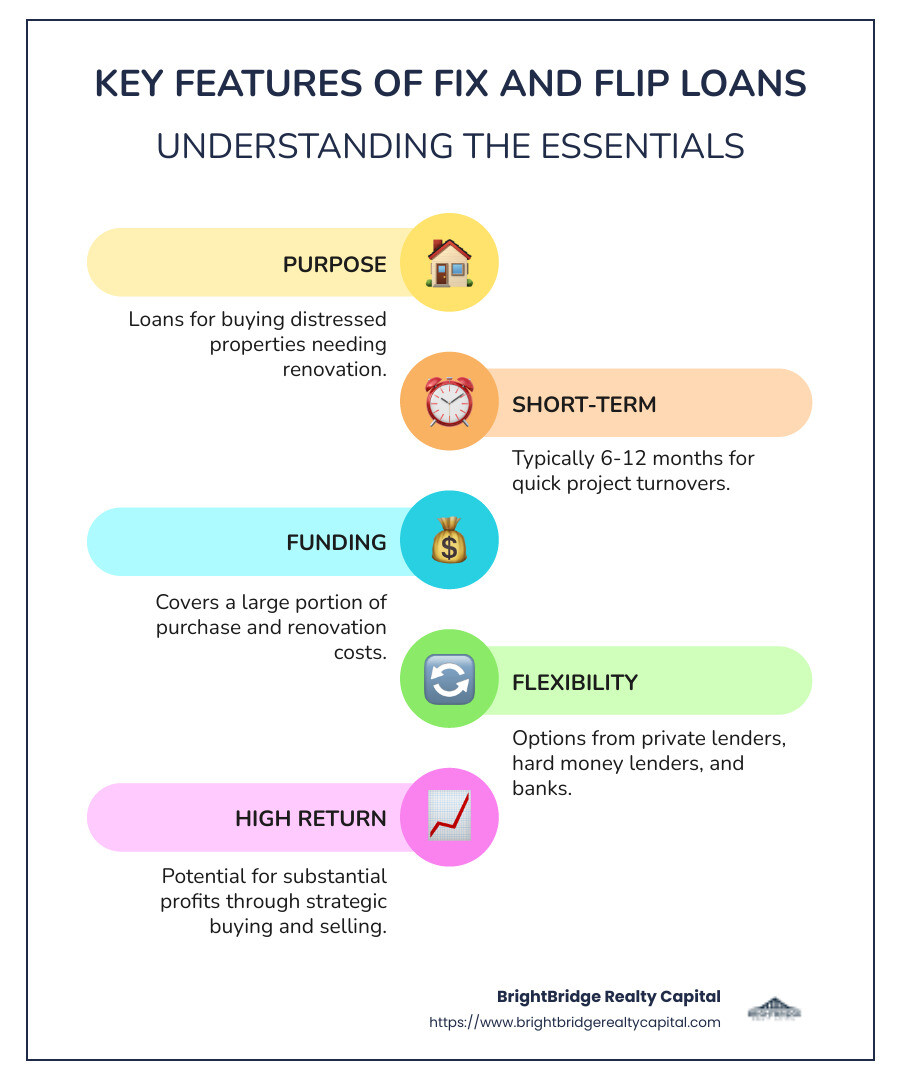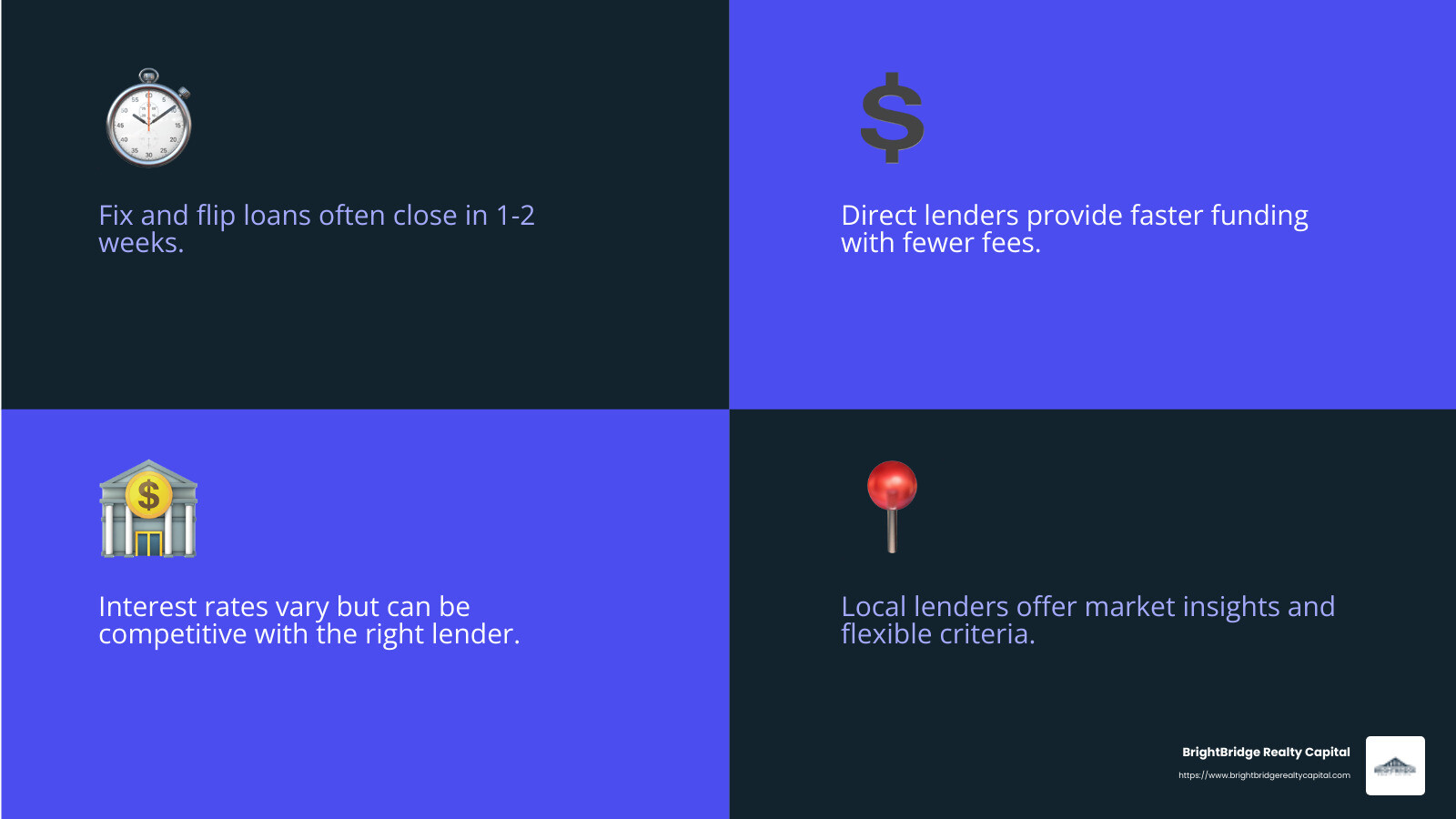Fix and Flip Loans Demystified: Your Path to Real Estate Success

Fix and flip loans offer a powerful way for real estate investors to make smart buys with big potential returns. Interested in diving into the fix-and-flip world? Here’s the quick scoop:
- Purpose: These loans are designed specifically for buying distressed properties in need of renovation.
- Short-Term: Typically lasting 6-12 months, ideal for quick project turnovers.
- Funding: Covers a significant portion of the purchase and renovation costs.
- Flexibility: Options from private lenders, hard money lenders, and even banks.
- High Return: Potential for substantial profits through strategic buying, efficient renovations, and timely sales.
In the competitive landscape of real estate, the strategy of buying, renovating, and selling properties quickly has become a lucrative avenue for many investors. With TV shows glamorizing the process, the concept of flipping homes has captured the imagination of budding real estate moguls seeking fast profitability. The secret weapon? Fix and flip loans, which are specialized financial tools custom to empower buyers to scoop up undervalued homes, carry out essential renovations, and then sell at a profit—all within a streamlined timeline.
For any investor keen on changing fixer-uppers into gems, understanding the intricacies of fix and flip loans is essential. These loans pave the way for fast acquisitions, enabling you to execute your vision with agility and precision.
Whether you’re a first-timer or an experienced flipper, navigating the options available in the fix and flip loan arena can markedly influence your bottom line.

Understanding Fix and Flip Loans
Fix and flip loans are specifically designed for real estate investors aiming to buy, renovate, and quickly sell properties for a profit. These loans come with unique features that cater to the nature of flipping houses.
Key Features of Fix and Flip Loans
Short-Term Financing: Fix and flip loans are typically short-term, ranging from 6 to 18 months. This period aligns with the project timelines of most house flipping ventures, allowing investors to buy, renovate, and sell properties quickly.
High Leverage: These loans often provide high leverage, meaning they cover a large portion of the purchase and renovation costs. Some lenders offer up to 90% of the purchase price and 100% of the renovation costs, minimizing the upfront cash required from the investor.
Interest Rates: Interest rates for fix and flip loans tend to be higher than traditional loans, typically ranging from 8% to 15%. This compensates lenders for the increased risk and the short-term nature of the loan.
Loan Terms: Loan terms are usually flexible, with options for interest-only payments during the renovation phase. This allows investors to manage cash flow effectively, as they are only required to pay the interest until the property is sold.
Rehab Costs: A significant portion of the loan can be allocated to cover rehab costs, ensuring that investors have the necessary funds to execute renovations and increase the property's value.
Types of Fix and Flip Loans
Hard Money Loans: These are the most common type of fix and flip loans. They are typically offered by private lenders and are secured by the property itself. Hard money loans are known for their quick approval process and flexibility, making them ideal for investors needing fast access to funds.
Private Money Loans: Similar to hard money loans, private money loans are sourced from individual investors rather than traditional financial institutions. These loans can be more flexible in terms of interest rates and loan terms, depending on the relationship and agreement between the borrower and lender.
Bank Loans: Although less common, some banks offer specialized fix and flip loans. These loans might have more stringent qualification criteria and longer approval processes but can offer lower interest rates compared to hard money and private loans.
By understanding these key features and types of fix and flip loans, investors can better steer the financial landscape and choose the right loan to maximize their real estate investments. This knowledge is crucial for executing successful flips and achieving profitable outcomes.
How to Secure a Fix and Flip Loan
Securing a fix and flip loan might seem daunting, but breaking it down into steps can make the process much smoother. Let’s dive into how you can prepare and choose the right lender for your next real estate venture.
Preparing Your Application
Before you approach a lender, ensure you have all your ducks in a row. Here’s what you need to focus on:
Pre-Approval: Start by getting pre-approved. This step gives you a clear idea of how much you can borrow, helping you target the right properties. Pre-approval also signals to sellers that you're serious, making your offers more competitive.
Application Process: Gather all necessary documents. This typically includes your credit report, proof of income, and details about your financial history. Lenders want to see that you’re a reliable borrower.
Eligibility Criteria: Understand what lenders are looking for. Most fix and flip loans require a minimum credit score and a certain level of experience in real estate investing. If you're new, consider partnering with a more experienced investor to boost your chances.
Project Details: Clearly outline your project. Include the property address, the scope of rehab work, and a detailed budget. Lenders want to know that you’ve done your homework and have a solid plan in place.
Property Address and Rehab Scope: Provide a comprehensive analysis of the property. Detail the current condition, the planned renovations, and how these will increase the property’s value. A well-prepared scope of work can make a significant difference in your application’s success.
Choosing the Right Lender
Finding the right lender is crucial. Here are some things to consider:
Fast Closings: Time is of the essence in real estate. Look for lenders who offer quick closing times. Some can close loans in as little as one to two weeks, allowing you to move swiftly on potential deals.
Direct Lending: Opt for direct lenders who can provide funds without intermediaries. This often results in faster processing times and fewer fees.
Competitive Rates: Compare interest rates and terms. While fix and flip loans tend to have higher rates than traditional mortgages, some lenders offer competitive rates that can save you money in the long run.
Experience in Real Estate Lending: Choose a lender with a strong track record in real estate. They’ll understand the nuances of the industry and can offer valuable insights and support.
Local Knowledge: If possible, work with local lenders who know the market. They can provide custom advice and might be more flexible in their lending criteria.

By preparing thoroughly and choosing the right lender, you'll be well-equipped to secure a fix and flip loan that aligns with your investment goals. This foundation is key to executing successful flips and achieving profitable outcomes.
Maximizing Profits with Fix and Flip Loans
Calculating Costs and Returns
Understanding how to calculate costs and returns is essential for maximizing profits in house flipping. Let's break down the key components.
1. Purchase Price
The purchase price is the first major cost to consider. Use the 70% Rule as a guide: aim to buy properties at 70% of the After Repair Value (ARV), minus renovation costs. This helps ensure a healthy profit margin.
2. Renovation Costs
Renovations are where the magic happens—but they can also eat into your profits if not managed well. Plan a detailed budget for all rehab work. Include costs for materials, labor, permits, and unexpected expenses. It's wise to overestimate slightly to cover any surprises.
3. After Repair Value (ARV)
The ARV is the estimated market value of the property after renovations are complete. Calculate this by comparing similar properties (comps) in the area. A precise ARV helps you set a realistic selling price and ensures your investment is worthwhile.
Common Pitfalls to Avoid
Flipping houses can be lucrative, but it comes with challenges. Here are some pitfalls to watch out for:
1. Delays
Time is money in real estate. Delays in renovations can increase holding costs, such as loan interest, property taxes, and utilities. Plan for potential delays by building a buffer into your timeline and working with reliable contractors.
2. High Interest Rates
Fix and flip loans often have higher interest rates than traditional loans. This can impact your profits if the project drags on. Shop around for competitive rates and consider interest-only payments to reduce costs during the rehab phase.
3. Market Fluctuations
Real estate markets can be unpredictable. A downturn can affect your selling price and delay sales. Stay informed about local market trends and be prepared to adjust your strategy if needed. This might mean holding the property longer or renting it out temporarily.
4. Contractor Selection
Hiring the right contractor is crucial. Vet potential contractors carefully: check references, review past work, and ensure they’re licensed and insured. A good contractor can keep your project on schedule and within budget, while a bad one can lead to costly overruns and delays.
By calculating costs accurately and avoiding common pitfalls, you can maximize your profits with fix and flip loans. This knowledge sets the stage for a successful real estate venture.
Frequently Asked Questions about Fix and Flip Loans
What is the typical duration of a fix and flip loan?
Fix and flip loans are designed to be short-term. They typically last between 6 to 18 months. This duration aligns with the goal of buying, renovating, and selling the property quickly. The exact term can vary depending on the lender and the specifics of the project. Some lenders, like BrightBridge Realty Capital, even offer flexible terms to suit different project timelines.
How do interest rates compare to traditional loans?
Interest rates for fix and flip loans are generally higher than those for traditional home loans. While traditional home loans might have rates between 2% to 4%, fix and flip loans can range from 8% to 18%. These higher rates reflect the increased risk and short-term nature of the investment. However, the potential for quick profits often outweighs the higher interest costs.
What properties qualify for fix and flip loans?
Fix and flip loans can be used for a variety of properties. These include single-family homes, condos, multi-unit residences, and even some commercial properties. The key is that the property must be suitable for renovation and resale. Lenders typically look at the property's potential After Repair Value (ARV) to determine its eligibility. Properties bought at auction or foreclosure are common candidates, as they often offer significant potential for value increase through renovation.
Conclusion
At BrightBridge Realty Capital, we know that the path to real estate success can be complex, but it doesn't have to be daunting. Our focus is on providing seamless processes and custom solutions that fit your unique needs as a real estate investor. With our expertise in fix and flip loans, we offer you the tools and support to turn potential into profit.
Our commitment to fast closings, often within a week, means you can seize opportunities as they arise without delay. Our direct lending approach eliminates intermediaries, ensuring competitive rates and a hassle-free experience from start to finish.
Real estate success is not just about finding the right property; it's about having the right partner to guide you through the financing landscape. Whether you're new to flipping or a seasoned investor, BrightBridge Realty Capital is here to help you steer the journey. We're dedicated to making your investment goals a reality with our expertise and personalized service.
Ready to take the next step in your real estate journey? Explore our loan options and start your application today. Let's turn your fix and flip ambitions into real success.


